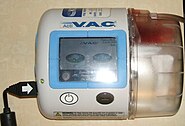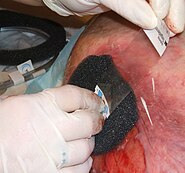Negative-pressure wound therapy
Negative pressure wound therapy (NPWT) is a technique of wound closure used to promote healing in large or chronic wounds, fight infection and enhance healing of burns. NPWT seals the wound with a gauze or foam dressing and applies negative pressure to the wound bed with a tube threaded through the dressing. The vacuum may be applied continuously or intermittently, depending on the type of wound being treated and the clinical objectives. Intermittent removal of used instillation fluid supports the cleaning and drainage of the wound bed and the removal of infectious material.[1][2][3][4]

Technique
NPWT has two forms which mainly differ in the type of dressing used to transfer NPWT to the wound surface: gauze or foam. The gauze type is referred to as the Chariker-Jeter technique and involves a drain wrapped in gauze topped by a sealed transparent dressing. The foam type uses a sealed polyurethane foam dressing attached by a tube to a vacuum pump.

A dressing, containing a drainage tube, is fitted to the contours of a deep or irregularly-shaped wounds and sealed with a transparent film. The tube is connected to a vacuum source, turning an open wound into a controlled, closed wound while removing excess fluid from the wound bed to enhance circulation and remove waste from the lymphatic system. The technique is usually used with chronic wounds, or wounds that are expected to present difficulties while healing (such as those associated with diabetes or when the veins and arteries are unable to provide or remove blood adequately.[5]
Effectiveness
A Chochrane Review of NPWT states that the studies conducted to date were methodologically flawed. It concluded that there is no evidence that NPWT significantly speeds healing when compared to alternative treatments, and that firm conclusions will require more and better-quality research.[6]
Studies have shown some particular advantages to using negative pressure wound therapy:
- Decreases wound volume [7]
- Removes excess serous fluids that can inhibit wound healing[8]
- Helps remove interstitial fluid[9]
- Promotes tissue granulation[10]
- Helps to decrease bacterial colonization at the wound site [11]
KCI
In 1995 the Food and Drug Administration was presented with and first approved negative pressure equipment that was subsequently marketed as the VAC (for vacuum assisted closure), by KCI (Kinetic Concepts, Inc). In medical trials, the treatment was as safe, and more effective, than moist treatment for diabetic ulcers.[12]
Gallery
-
Diabetic foot ulcer prior to treatment
-
After treatment
References
- ^ Bernstein, BH (2005). "Combination of subatmospheric pressure dressing and gravity feed antibiotic instillation in the treatment of post-surgical diabetic foot wound: a case series". Wounds. 17 (2): 37–48.
{{cite journal}}: Unknown parameter|coauthors=ignored (|author=suggested) (help) - ^ Fleischmann, W (1998). "Die Vakuumversieglung als Trägersystem für eine gezielte lokale Medikamentenapplikation bei Wundinfektionen". 101: 649–654.
{{cite journal}}: Cite journal requires|journal=(help); Unknown parameter|coauthors=ignored (|author=suggested) (help); Unknown parameter|jounral=ignored (help) - ^ Wolvos, T (2004). "Wound instillation – the next step in negative pressure wound therapy. Lessons learned from initial experiences". Ostomy Wound Manage. 50: 56–66.
- ^ Moch D, Fleischmann W, Westhauser A (1998). "[Instillation vacuum sealing--report of initial experiences]". Langenbecks Arch Chir Suppl Kongressbd (in German). 115: 1197–9. PMID 9931834.
{{cite journal}}: CS1 maint: multiple names: authors list (link) - ^ Miller, MS (2005). "Negative pressure wound therapy options promote patient care". BioMechanics. 12 (9): 49–57.
{{cite journal}}: Unknown parameter|coauthors=ignored (|author=suggested) (help) - ^ Ubbink DT, Westerbos SJ, Evans D, Land L, Vermeulen H (2008). "Topical negative pressure for treating chronic wounds". Cochrane database of systematic reviews (Online) (3): CD001898. doi:10.1002/14651858.CD001898.pub2. PMID 18646080.
{{cite journal}}: CS1 maint: multiple names: authors list (link) - ^ Joseph E., Hamori CA., Bergman S., Roaf E., Swann N., Anastasi G. Prospective Randomized Trial of Vacuum-Assisted Closure versus Standard Therapy of Chronic Non-healing Wounds. Wounds, 2000; 12(3) [1]
- ^ Bucalo B, Eaglstein WH, Falanga V (1993). "Inhibition of cell proliferation by chronic wound fluid". Wound Repair Regen. 1 (3): 181–6. doi:10.1046/j.1524-475X.1993.10308.x. PMID 17163887.
{{cite journal}}: Unknown parameter|month=ignored (help)CS1 maint: multiple names: authors list (link) - ^ Morykwas MJ, Argenta LC, Shelton-Brown EI, McGuirt W (1997). "Vacuum-assisted closure: a new method for wound control and treatment: animal studies and basic foundation". Ann Plast Surg. 38 (6): 553–62. PMID 9188970.
{{cite journal}}: Unknown parameter|month=ignored (help)CS1 maint: multiple names: authors list (link) - ^ Argenta, A., Webb K., Simpson J., Gordon S., Kortesis B., Wanner M., Kremers L., Morykwas M. Deformation of Superficial and Deep Abdominal Tissues with Application of a Controlled Vacuum. European Tissue Repair Society, Focus group meeting Topical Negative Pressure (TNP) Therapy, 4–6 December 2003, London.
- ^ Fleck CA, Frizzell LD. When negative is positive: a review of negative pressure wound therapy[2]
- ^ Blume PA, Walters J, Payne W, Ayala J, Lantis J (2008). "Comparison of negative pressure wound therapy using vacuum-assisted closure with advanced moist wound therapy in the treatment of diabetic foot ulcers: a multicenter randomized controlled trial". Diabetes Care. 31 (4): 631–6. doi:10.2337/dc07-2196. PMID 18162494.
{{cite journal}}: Unknown parameter|month=ignored (help)CS1 maint: multiple names: authors list (link)
